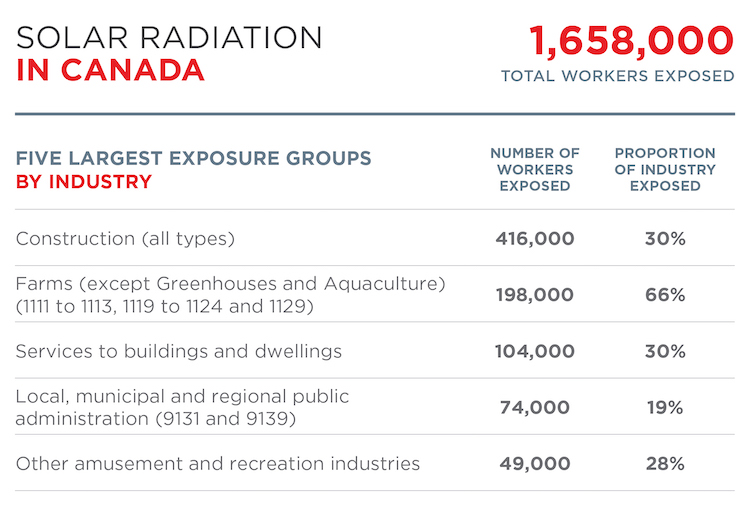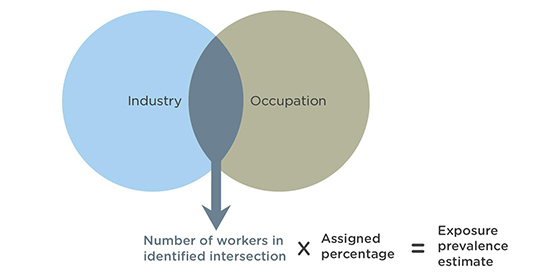Solar UV Radiation Occupational Exposures
Solar UV Radiation Occupational Exposures
Overview
Exposure to solar UVR may be dermal or ocular in occupational settings.
CAREX Canada estimates that approximately 1.7 million Canadians are exposed to solar ultraviolet radiation in their workplaces.
READ MORE...
All outdoor occupations have a potential for exposure to solar radiation.[1] The largest industrial groups exposed include construction, farming, and services to buildings and dwellings. The largest occupational groups exposed are farmers and farm managers, construction trades helpers, landscaping and ground maintenance labourers, and heavy equipment operators.
Other job categories with a potential for exposure to solar UVR include logging, fishing, open-pit mining, road building, and maintenance, as well as athletes, maintenance workers, pipeline workers, military personnel and police, ski instructors, lifeguards, oilfield workers, postal carriers, surveyors, sailors, and railway track workers.[1,2] Indoor workers receive only 10-20% of outdoor workers’ annual exposure to solar UVR.[3]
According to the Burden of Occupational Cancer in Canada project, occupational exposure to solar radiation leads to approximately 4,600 non-melanoma skin cancers each year, based on past exposures (1961-2001).[4,5] This amounts to 6.3% of non-melanoma skin cancer cases diagnosed annually. Most occupational non-melanoma skin cancers associated with solar radiation occur among workers in the agricultural and construction sectors. Work-related solar radiation exposure resulted in approximately $34.2 million in costs for newly diagnosed non-melanoma skin cancer cases in 2011.[6]
Prevalence Estimate
Results show that approximately 1.7 million Canadians (nearly 1 in 10 workers) are potentially exposed to solar ultraviolet radiation (UVR) at work; 80% of these workers are male. The largest industrial group exposed is construction (all types aggregated together), followed by farms, and services to buildings and dwellings.
When UVR exposure is examined by occupation, the largest exposed groups are farmers and farm managers (198,000 workers exposed), construction trades helpers (149,000 workers exposed), landscaping and grounds maintenance labourers (116,000 workers exposed), and heavy equipment operators (92,000 workers exposed).
The number of workers exposed to solar radiation increased by approximately 180,000 workers from 2006 to 2016 (a 12% increase). This was primarily driven by an increase in the number of workers in the construction industry and transportation and warehousing. Additional occupations and industries with exposed workers were also identified using the Government of Canada Career Handbook.
Workers exposed to solar UVR by industry in 2016

Workers exposed to solar UVR by region in 2016
Click the second tab to view total number of workers exposed.
Level of Exposure
In total, approximately 1.7 million Canadians are exposed to solar ultraviolet radiation (UVR) in their workplaces. The majority of workers exposed to solar UVR are in the high exposure category (871,000 workers or 53% of exposed workers). A significant number of workers are also exposed in the moderate and low exposure categories.
Workers exposed to solar UVR by exposure level in 2016
Level of exposure by industry
Identifying industries with either 1) workers exposed to high levels of solar UVR or 2) a larger number of workers exposed to solar UVR is important in guiding cancer prevention efforts to prioritize exposed groups and target resources most effectively.
The table below shows the number of workers exposed by industry group and level of exposure to solar UVR. These results highlight industries with the most number of workers, as well as industries with the highest levels of exposure.
Solar UVR exposure is most often high in the largest exposed groups. On farms, 96% of the workers are in the highest category of exposure, meaning those workers are expected to be outdoors ≥75% of their workday. In contrast, in educational services and truck transportation, most workers are exposed at a low level. Depending on the goals of a prevention campaign, exposure reduction in the large industrial group might be a useful strategy, or reducing exposure to those at highest risk of exposure could be seen as a priority.
*Numbers may not add up due to rounding
Methods and Data
Our Occupational Approach page outlines the general approach used to calculate prevalence and exposure level estimates for workplace exposures.
Data Sources
Data used in developing the occupational estimates for solar UVR were collected from several sources:
- Cancer prevention workbook developed by the SunSmart program at Cancer Council Australia
- Government of Canada Career Handbook
- Canadian and US scientific peer reviewed publications that addressed sun exposure in Canada and the United States.
- Grey literature including technical reports from governments and international bodies.
Prevalence Estimate Method
Exposure to solar UVR is defined broadly as physical exposure at work to the sun that is likely to exceed typical non-occupational exposure (not including heavy recreational sunbathers). It does not include exposure to artificial exposures of UV radiation (i.e. tanning beds, exposures due to welding, etc.). Artificial UV exposures have also been examined by CAREX Canada and estimates for occupational exposures are available on the website.
To determine the number of workers potentially exposed to solar UVR at work, CAREX occupational exposure experts used methods previously established in other peer-reviewed CAREX projects in Europe. A series of steps were taken to assign exposure proportions to occupations and industries at risk of exposure to solar UVR.

- Occupations and industries at risk of possible exposure to solar UVR were identified using any combination of data sources described above.
- The total number of workers in each identified occupation and industry intersection was obtained from Statistics Canada 2016 census data.
- A percentage of workers exposed was assigned to that occupation and industry intersection. Percentages were determined by consultation with existing evidence in the data sources, previously established methods from the Europe CAREX estimates and the expert judgement of CAREX occupational hygienists.
- The number of workers in the identified group is multiplied by the assigned percentage to calculate the prevalence estimate of workers exposed to solar UVR.
Detailed description of data sources and exposure assessment methods are published as a paper in the Canadian Journal of Public Health.
Exposure Level Method
To develop estimates of both the prevalence and levels of solar ultraviolet radiation (UVR) exposure, we used a skin cancer prevention workbook developed by the SunSmart program at Cancer Council Australia1 to identify jobs at high risk of exposure. To create the Low and Moderate categories of exposure, we used websites that describe tasks by job title and include information on whether or not the job includes outdoor work (and how much).2,3
For solar UVR exposure, these categories of exposure are:
Category 1: Low Exposure
A group of workers (people in the same job category) is put in this exposure category if job description websites and literature review shows that outdoor work is uncommon for the job title.
Category 2: Moderate Exposure
A group of workers is put in this exposure category if:
- A job entails both indoor and outdoor work, and all workers in that job are required to work outdoors at least some of the time, OR
- A job has some people who work outdoors and some who work indoors.
Category 3: High Exposure
A group of workers is put in this exposure category if they are expected to be outside ≥75% of their workday. These workers were identified using occupational skin cancer prevention tools used to target workers at high risk of exposure to the sun’s rays.
Sources
- Cancer Council Australia’s Skin Cancer Committee. Skin cancer and outdoor work: A guide for employers. Victoria, Australia: The Cancer Council Victoria 2007:1-31.
- Alberta Learning Information Service. OCCinfo: Alberta Occupational Profiles. (2012).
- Ontario Ministry of Training, Colleges and Universities. Ontario Job Futures Program, Job Profiles. (2012).
Sources
Subscribe to our newsletters
The CAREX Canada team offers two regular newsletters: the biannual e-Bulletin summarizing information on upcoming webinars, new publications, and updates to estimates and tools; and the monthly Carcinogens in the News, a digest of media articles, government reports, and academic literature related to the carcinogens we’ve classified as important for surveillance in Canada. Sign up for one or both of these newsletters below.
CAREX Canada
School of Population and Public Health
University of British Columbia
Vancouver Campus
370A - 2206 East Mall
Vancouver, BC V6T 1Z3
CANADA
As a national organization, our work extends across borders into many Indigenous lands throughout Canada. We gratefully acknowledge that our host institution, the University of British Columbia Point Grey campus, is located on the traditional, ancestral and unceded territories of the xʷməθkʷəy̓əm (Musqueam) people.



